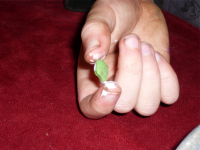
There are so many things to like about driftwood. For instance, you have to go to the beach to get it. Also, it’s softer than other wood (or at least it usually is — more on this later), so it’s easier for children and wimps like me to nail into it. And, of course, it’s beautiful!

A couple of years ago, I saw a piece of wall art in a catalog that was made out of driftwood. I decided it was too expensive to buy and would be a fun project to try with the kids. In a couple of afternoons we successfully built a passable driftwood fish skeleton that made a nice Father’s Day gift. It’s hung in our living room ever since.
This year, we decided to make a couple more as gifts for the grandfathers. It really couldn’t be a simpler project.


- Gather some driftwood, watching for a slightly curved longer piece and lots of smaller, skinnier pieces that will make nice bones to go along the spine. Does anyone know if these are considered ribs in a fish? Also, watch for pieces that will make good fish heads and/or fish tails.
- While you’re at the beach, pick up some small, roundish rocks, seashells, or sea glass (if you’re lucky!) to use as the fish’s eye.
- Get some small finishing nails in various lengths — we used some with heads and some without.
- Bring out a hammer and some craft glue to construct the beast, and grab something to use to hang the wall art (we used burlap twine, an old shoelace, and some synthetic raffia). Now you’re ready to build.
- Design the fish! Lay the larger curved stick down on the table horizontally; this is the spine of your fish. Choose a head and a tail, and choose the ends that each will best fit on. Pick one of the skinnier sticks to be the center of the spine, and lay it vertically on the middle of your fish spine; it should be slightly longer than most of the others you’ll use. Then lay out sticks on either side of the center stick, stepping down in length until you reach the head and tail.



- Nail on your components. It seems to work best if you nail on the head and tail first; then I usually nail down the center stick and work my way out. In terms of nailing on the pieces, I usually get the nail through the “bone” first, on a flat piece of driftwood or a 2×4. Then I place that piece on the spine and gently nail it all the way in to secure it.
- Glue on an eye and tie on a hanger. We’ve used sea glass and abalone shells, but we considered using on of those flattened glass marbles, a blue bead, and a pretty rock. For the hanger, I just tied on a length of twine on both ends; you can use the knots to control the angle that your fish art hangs against the wall.
For us, everything went really well with nailing the first one together. We were done in practically no time and we were all still enjoying ourselves and in a good mood.
But the stick we chose for the spine of the second fish was very problematic, even if it already had a perfect fish tail on one end. Every nail we hammered in would only penetrate a little bit and then would bend. I’ve decided that the inner two-thirds of the stick was fossilized; there can really be no other answer. Anyway, we finally got them all secured, but if you look closely you’ll see a lot of bent shiny nails adorning the bones on the bigger fish. Piscine bling, maybe?



Even so, we’re happy and proud of our work. I hope the granddads will appreciate the effort, and I’d love to see photos of any that you readers make, or maybe similar projects you’ve done in the past with driftwood. Or post suggestions in the Comments; we have lots more driftwood to use!
ADVERTISEMENT





